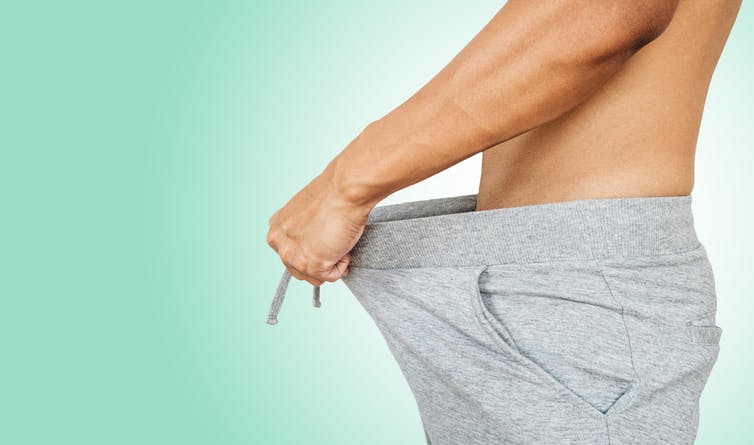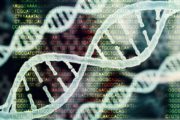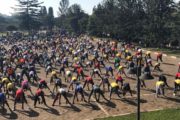Helle Gerbild, University of Southern Denmark; Christian Graugaard, Aalborg University, and Kristina Areskoug-Josefsson, Jönköping University
Men with erectile dysfunction can improve their sexual function with 40 minutes of aerobic exercise, four times a week, according to our latest review of the evidence.
We reviewed all international studies carried out over the past ten years where inactive men with erectile dysfunction received professional help to become physically active. The results showed that most of the time it is possible to reduce erection problems with exercise.
Erectile dysfunction is the most common male sexual dysfunction. It is defined as a consistent or recurring inability to get and maintain an erection sufficient for sexual activity. In other words, persistent problems in getting it up or keeping it up during intercourse or masturbation.
Erectile dysfunction, including weakened night and morning erections, may be an early sign of health problems and, sometimes, a symptom of early-stage atherosclerosis (stiffening and narrowing of the arteries).
We know that erection problems are more common in smokers and in men who are physically inactive or overweight. It is also more common in men with high blood pressure, cardiovascular diseases and diabetes. So erection problems may be the first sign of vascular disease.
About 23% of inactive men and about 23-40% of obese men suffer from erectile dysfunction, as do 40% of men receiving treatment for high blood pressure and 75% of men with cardiovascular disease. By comparison, 18% of men in the general population have, or have had, erectile dysfunction.
Hardening of the arteries
When a man becomes sexually aroused, blood flows to his penis and the increased blood in the erectile tissue results in an erection. But in men with atherosclerosis the penile artery walls become thick and lose their elasticity. Three-quarters of erection problems are linked to atherosclerosis, a condition typically triggered by lifestyle factors, such as obesity, physical inactivity and smoking.
We already knew that lifestyle modifications, including physical activity, improved vascular health, sexual health and erectile function. Exercise is the lifestyle factor most strongly associated with erectile function and widely recognised as the most important promoter of vascular health, as physical activity improves blood circulation in the body, including the penis. We also knew that there is strong evidence that frequent physical activity significantly improves erectile function.
For our study, we wanted to know how much physical activity is needed to improve erectile function. We saw that physical activity of moderate to high intensity for 40 minutes, four times a week for six months resulted in an improvement or even a normalisation of the person’s erection. After six months of physical activity, men who could not masturbate or have sex for a long time were able to resume sexual activity.
The figure below shows, on a scale of 0-30 points, the average erectile function of men in different studies before and after the intervention (exercise). In all studies, men had improved erectile function.
Take-home message
If you are physically inactive and in bad shape, it’s important to not push yourself into a fitness regime that is beyond you, otherwise, you risk injury, which could make exercising difficult and reduce your motivation to continue.
The best approach is to start with simple aerobic activity. Walk every day, swim or cycle, and increase the pace and distance week by week. After a few weeks, you could add jogging, dancing, tennis or football into the mix. Or, if you prefer, you could join a gym.
To strengthen blood circulation – throughout the body and also the penis – exercise intensity must be moderate to high. This means that you warm up your body and produce sweat, your face turns red, your pulse increases and you become slightly breathless – breathless enough to make it difficult to have a conversation.
If your erectile dysfunction is caused by early stages of atherosclerosis, 160 minutes of physical activity weekly for six months will probably improve your ability to get an erection.
A physically active lifestyle should be considered as the beginning of more permanent lifestyle changes. If you are overweight, the effect of the physical activity can be further increased by losing weight. And if you smoke, the effect of physical activity becomes even stronger by quitting.
But changing your lifestyle from being physically inactive to being physically active is easier said than done, so it is best to seek professional help. Physiotherapists can help to evaluate your fitness level and potential. Also, they can provide you with a personalised training programme and guide and support you as you gradually increase your level of physical activity.
And exercise is much more enjoyable when you do it with others. So why not invite your partner or friends to join you? After all, training is healthy, but it should also be fun.
This article is co-published with ScienceNordic and in Danish on Forskerzonen.
Helle Gerbild, Assistant Researcher in Public Health, University of Southern Denmark; Christian Graugaard, Professor of Sexology, Aalborg University, and Kristina Areskoug-Josefsson, Associate Professor, Jönköping University
This article is republished from The Conversation under a Creative Commons license. Read the original article.
Warning: file_get_contents(https://plusone.google.com/_/+1/fastbutton?url=https%3A%2F%2Fkigalihealth.com%2Ferectile-dysfunction-exercise-could-be-the-solution%2F): failed to open stream: HTTP request failed! HTTP/1.0 404 Not Found in /home/kigal4health/public_html/wp-content/themes/goodnews5/goodnews5/framework/functions/posts_share.php on line 151














